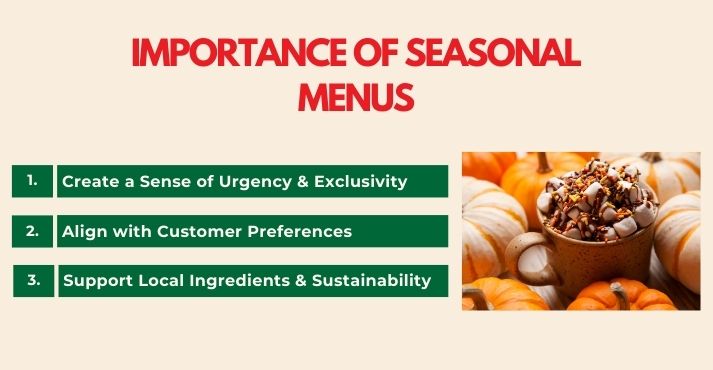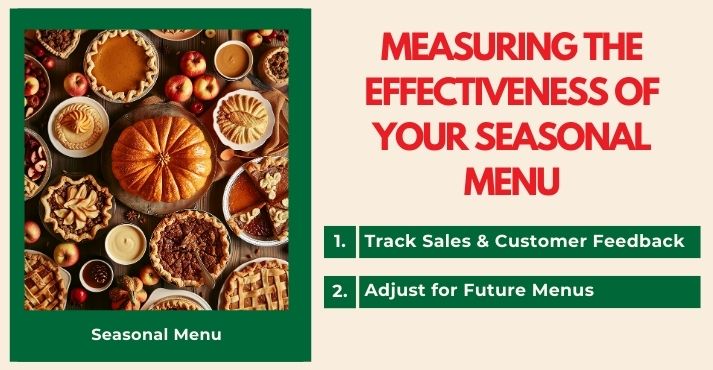A seasonal menu changes with the time of year. As the weather shifts, people naturally want different kinds of food. For example, a cold salad doesn’t appeal the same way in January as it does in July.
Updating your menu throughout the year lets you meet these changing tastes without a complete redesign.
There are also benefits behind the scenes. In-season ingredients are usually easier to find, taste better, and often cost less. This simplifies preparation, keeps quality high, and helps control food costs. It also gives the kitchen team room to be creative without extra pressure.
Most importantly, a seasonal menu keeps customers interested. It gives them a reason to return and try something new. Regular guests enjoy the variety, and limited-time dishes can attract new diners. It’s an easy way to keep your restaurant fresh and responsive.
Importance of Seasonal Menus

Rotating your menu based on the time of year isn’t just a kitchen trend. It’s a smart business move that keeps your offerings relevant, fresh, and engaging.
It allows you to meet changing customer expectations, take advantage of what’s in season, and add variety without reinventing the entire menu.
1. Create a Sense of Urgency and Exclusivity
Limited-time items make people want to try them before they’re gone. When a dish is available for only a short window, it naturally creates urgency.
Many well-known brands have used this to their advantage. Starbucks, for example, brings in a rush of customers each fall with its Pumpkin Spice Latte. McDonald’s does the same with its occasional McRib comeback.
Restaurants of any size can apply this strategy. A fall-only butternut squash ravioli or a spring rhubarb tart gives customers a reason to come in before it’s gone.
Labeling a dish as seasonal does more than signify freshness. According to recent research, 59% of consumers are more likely to order a dish when labeled as seasonal. This simple change can lead to stronger customer response and more frequent visits.
2. Align with Customer Preferences
Appetites change throughout the year. People seek lighter meals, fresh produce, and cooler drinks when the temperature rises. When it drops, they lean toward comforting, hearty dishes.
Along with weather, customer preferences are influenced by holidays, school schedules, and different food trends. Seasonal menus help you adjust quickly to these changes.
A summer-focused menu might lean into grilled seafood, crisp greens, and bright citrus. On the other hand, a winter lineup could feature braised meats, roasted root vegetables, and warm spice-forward desserts. These kinds of seasonal adjustments help customers feel seen and understood.
Using seasonal ingredients for menus shows you’re keeping up with changing tastes. It also signals that your kitchen is tuned into what guests genuinely want to eat right now, not what felt relevant six months ago.
3. Support Local Ingredients and Sustainability
Seasonal menu planning helps you build stronger connections with local growers and producers.
In-season ingredients are usually easier to source locally, making them fresher, more flavorful, and more cost-effective. Using local items gives your menu a sense of place and authenticity that diners notice.
Many customers today care about where their food comes from. They’re attracted to businesses that make responsible choices and support community values.
Showing local farms or producers on your menu supports this idea and shows your restaurant cares about sustainable sourcing.
It’s also a practical step toward reducing your environmental impact. When ingredients travel fewer miles, it helps reduce environmental harm. You cut down on packaging, transportation, and spoilage while improving the taste and story behind every dish.
Components of a Successful Seasonal Menu

Creating a seasonal menu that resonates takes more than swapping out a few ingredients. It requires thoughtful planning and understanding what your guests want at different times of the year.
A thoughtfully planned seasonal menu can boost your kitchen’s efficiency and improve the guest experience. Below are a few significant components to remember when building or refining your seasonal offerings.
1. Seasonal Ingredients
Fresh, in-season ingredients are essential for a successful seasonal menu. These ingredients are at their peak flavor and quality because they are harvested at the right time.
This improves the taste of your dishes and can lower food costs since local, in-season produce or meats are often more readily available and less expensive.
Connect with local farmers’ markets or suppliers to identify what’s in season. For example, fall menus often include pumpkin, butternut squash, and root vegetables, while summer menus focus on fresh seafood, tomatoes, and berries.
Blue Hill at Stone Barns is a great example, as it builds its menu around seasonal, farm-fresh ingredients, offering dishes based on daily harvests.
Incorporating seasonal ingredients enhances flavor and gives your menu authenticity that casual and fine dining guests appreciate.
2. Rotating Special Dishes
Regularly updating your menu with rotating specials keeps your offerings exciting and encourages repeat visits.
Customers appreciate variety, and rotating dishes lets you try new ideas without changing your menu. This helps create a smart menu rotation strategy that balances fresh options with familiar favorites.
Timing is crucial when introducing new specials. Launch them alongside seasonal changes or holidays to align with guest expectations and maximize impact. Promote new dishes through social media, newsletters, and in-restaurant signage to build buzz.
3. Pairing with Seasonal Beverages
Seasonal food menus are incomplete without thoughtfully paired drinks. Offering seasonal beverages such as specialty cocktails, warm drinks in winter, or refreshing iced teas in summer enhances the overall dining experience.
Beverage pairings match the flavors and textures, making the meal more memorable.
For instance, serving a warm apple cider or a spiced mulled wine with fall dishes creates a cozy vibe, while an iced green tea pairs perfectly with a light summer salad. Many restaurants create seasonal drink menus to make the guest experience better.
A standout example is Jigger & Pony, a renowned bar in Singapore. Their “A Decent Menu” features over 20 innovative cocktails, including the “Corn Colada,” which combines Bacardi Reserva Ocho 8 Year Old Rum with corn, butter, lime, and egg white.
Their creative drinks show how much they value seasonal ingredients and unique flavors.
How to Plan and Implement Your Seasonal Menu

Planning a seasonal menu takes more than swapping ingredients. It requires understanding your customers, sourcing the right products, and staying flexible as conditions change.
When done thoughtfully, it can improve your guest journey, boost sales, and set your restaurant apart in the food service industry.
1. Understand Your Customer Demographics
Start by learning what your guests want. Use surveys, social media feedback, or direct conversations to gather insights on their preferences. Some customers might prioritize health and seek vegan or low-calorie options, while families may look for comforting, familiar dishes.
Segmenting your audience, for example, health-conscious diners, families, or foodies, helps you create seasonal menu ideas that appeal to each group. Paying attention to cultural events or holidays also helps you introduce timely dishes that feel relevant.
2. Choose Seasonal Ingredients
Creating a seasonal menu depends heavily on fresh local ingredients. Partnering with nearby farmers and vendors ensures you get the best produce and supports sustainable food practices.
According to recent research, 60% of consumers are willing to pay more for locally sourced ingredients, making this a strong selling point for your menu and marketing. Showing off local products helps connect with customers who value quality and supporting their community.
3. Maintain Flexibility for Changing Seasons
Even the best-laid plans can face hurdles. Weather changes or supply chain interruptions might affect what is available. Build flexibility into your menu by having backup dishes ready if certain ingredients run out.
This keeps your menu dynamic and helps maintain consistency without disappointing customers. Adjusting quickly shows smart menu psychology and reassures guests that your restaurant can keep serving quality dishes in any situation.
4. Consider Dietary Trends
Consider common dietary preferences such as gluten-free, vegan, and low-carb diets. Use seasonal ingredients in these options to meet customer needs and keep the menu fresh.
For example, offer a hearty plant-based vegetable stew in the fall or a light gluten-free berry dessert during summer. Marking these dishes helps guests quickly find suitable choices, improving their overall experience.
Catering to these trends helps you reach more customers and shows you’re paying attention to changing tastes and health needs. Offering variety is essential for making your seasonal menu appeal to a wide range of diners.
5. Price It Right
Seasonal ingredients can sometimes come at a higher cost due to limited availability or transportation challenges. Consider balancing premium dishes with more affordable options to serve different budgets when setting prices.
Offering smaller portion sizes of high-cost items can make those dishes more accessible without sacrificing quality. Be transparent about using locally sourced and sustainable food, as many customers recognize and appreciate the value behind these choices.
Clear communication about ingredient sourcing helps justify prices and builds trust. Thoughtful pricing ensures your seasonal menu remains attractive and profitable, keeping guests satisfied and encouraging them to return.
Marketing Your Seasonal Menu

Once your seasonal menu is in place, promoting it effectively turns great dishes into increased foot traffic and revenue. Strategic marketing helps generate buzz, attract new customers, and keep your regulars returning to see what’s new.
1. Promote through Limited-Time Offers
Limited-time offers can spark interest and encourage quick action. By offering seasonal dishes for a short period, restaurants tap into customers’ fear of missing out.
Specials like early access, “first 100 customers,” or limited-time discounts can quickly increase customer visits.
Restaurants using these time-sensitive promotions often experience a significant increase in sales. Some have reported up to a 20% increase in sales during these promotional windows compared to regular sales periods.
For example, Shake Shack regularly introduces seasonal shakes and burgers that generate strong demand and long lines. Their summer shakes, like the popular Salted Caramel Pretzel and the Mango Pie Shake, create buzz and encourage customers to visit while the flavors last.
In a commercial kitchen, these short-run items also help manage supply, reducing waste while keeping operations focused. This strategy excites customers and supports efficient inventory control and smooth kitchen workflow.
2. Leverage Social Media
Social media works well to show off your seasonal menu. High-quality images, behind-the-scenes kitchen moments, and short clips of dishes being plated can draw attention and generate conversation.
Creating a hashtag around your seasonal menu invites customers to share their experiences. Hosting photo contests or giveaways for the best post gives diners a reason to engage and return.
Sharing testimonials, highlighting popular items, and offering sneak peeks all add value. A consistent social media presence for a full-service restaurant keeps your brand at the forefront of your mind and shows off the care that goes into each dish.
3. Partner with Influencers
Working with local food influencers can expand your reach and add credibility. Influencers who align with your brand can introduce your seasonal menu to new audiences in a relatable, trusted way.
Influencer marketing increases audience engagement for 59% of businesses, improving credibility, trust, and revenue growth for 55%. A single well-timed post or video review can lead to a noticeable bump in bookings or visitors.
Collaborating with influencers gives your seasonal offerings more visibility while building a stronger connection with your local dining community.
Measuring the Effectiveness of Your Seasonal Menu

To know if your seasonal menu is working, tracking its results and listening to your customers is important. Measuring success helps you see what works well and needs improvement, so you can keep offering food and beverages that delight your guests.
1. Track Sales and Customer Feedback
Monitor sales data to see which seasonal dishes are popular and which are not selling. Use POS systems to gather precise sales figures and spot trends over time.
Pay attention to customer feedback from surveys, comment cards, or online review sites to gain insights into taste preferences and dining experiences.
Repeat visits and positive comments are strong signs that your seasonal menu meets customer expectations. Combining sales data with direct feedback gives a fuller picture of your menu’s impact on your business.
2. Adjust for Future Menus
Use the data collected to improve upcoming seasonal menus. Remove items that didn’t perform well and bring back customer favorites to increase satisfaction.
Hold post-season meetings with your team to review sales figures and customer input, discussing ways to refine recipes or presentation.
Consider testing new seasonal menu ideas based on feedback and trends. This regular evaluation process helps keep your offerings aligned with customer tastes while supporting business goals and minimizing waste in your kitchen.
Conclusion
Seasonal menus offer a powerful way to keep your restaurant dynamic and appealing. They create a sense of urgency by offering limited-time dishes, encouraging customers to visit sooner rather than later.
Using locally sourced ingredients supports sustainable food practices and connects your business to the community, which many guests value highly.
Seasonal menus bring excitement through fresh flavors and rotating dishes, keeping the dining experience new and interesting for returning customers. This also helps manage kitchen operations efficiently by aligning with available ingredients and reducing waste.
By carefully planning your seasonal food and beverages, promoting your menu through limited-time offers, social media, and influencer partnerships, and measuring the results, you can improve customer satisfaction and sales.













